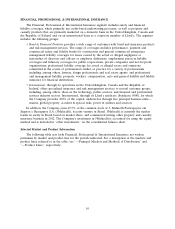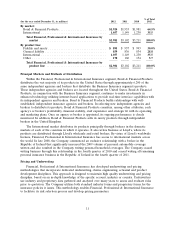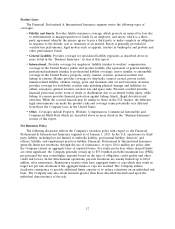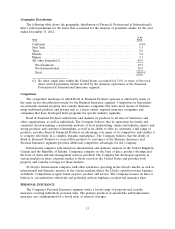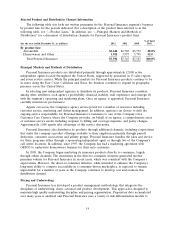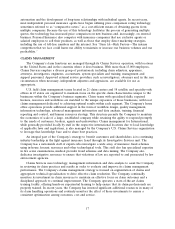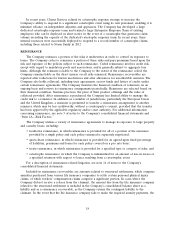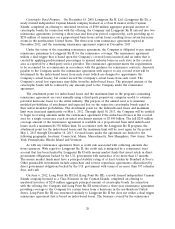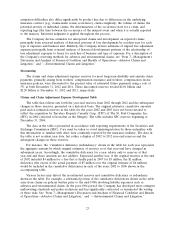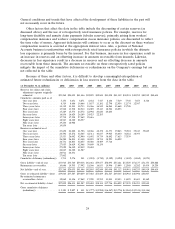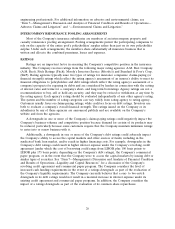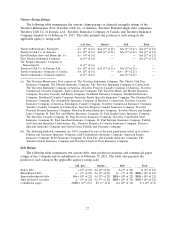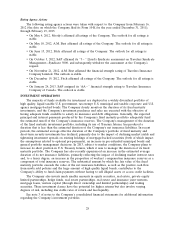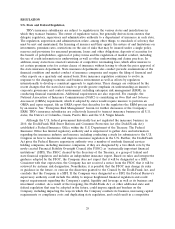Travelers 2012 Annual Report Download - page 32
Download and view the complete annual report
Please find page 32 of the 2012 Travelers annual report below. You can navigate through the pages in the report by either clicking on the pages listed below, or by using the keyword search tool below to find specific information within the annual report.Catastrophe Bond Program. On December 18, 2009, Longpoint Re II, Ltd. (Longpoint Re II), a
newly formed independent Cayman Islands company licensed as a Class B insurer in the Cayman
Islands, completed an offering to unrelated investors of $500 million aggregate principal amount of
catastrophe bonds. In connection with the offering, the Company and Longpoint Re II entered into two
reinsurance agreements (covering a three-year and four-year period, respectively), each providing up to
$250 million of reinsurance on a proportional basis from certain losses resulting from certain hurricane
events in the northeastern United States. The three-year term reinsurance agreement expired in
December 2012, and the remaining reinsurance agreement expires in December 2013.
Under the terms of the remaining reinsurance agreement, the Company is obligated to pay annual
reinsurance premiums to Longpoint Re II for the reinsurance coverage. The reinsurance agreement
utilizes a dual trigger that is based upon the Company’s covered losses incurred and an index that is
created by applying predetermined percentages to insured industry losses in each state in the covered
area as reported by a third-party service provider. The reinsurance agreement meets the requirements
to be accounted for as reinsurance in accordance with the guidance for reinsurance contracts. Amounts
payable to the Company under the reinsurance agreement with respect to any covered event will be
determined by the index-based losses from such event (which are designed to approximate the
Company’s actual losses), but cannot exceed the Company’s actual losses from such event. The
Company’s actual loss experience may differ from the index-based losses. The principal amount of the
catastrophe bonds will be reduced by any amounts paid to the Company under the reinsurance
agreement.
The attachment point for index-based losses and the maximum limit in the program’s remaining
reinsurance agreement are reset annually using a third-party proprietary computer model to estimate
potential hurricane losses for the entire industry. The purpose of the annual reset is to maintain
modeled probabilities of attachment and expected loss on the respective catastrophe bonds equal to
their initial modeled probabilities. The attachment point for the indexed-based losses and maximum
limit were increased significantly on May 1, 2012. Through April 30, 2013, the Company will be entitled
to begin recovering amounts under the reinsurance agreement if the index-based losses in the covered
area for a single occurrence reach an initial attachment amount of $3.500 billion. The full $250 million
coverage amount of the reinsurance agreement is available on a proportional basis until index-based
losses reach a maximum $4.358 billion limit. In accordance with the Longpoint Re II program, the
attachment point for the index-based losses and the maximum limit will be reset again for the period
May 1, 2013 through December 18, 2013. Covered losses under the agreement are limited to the
following geographic locations: Connecticut, Maine, Massachusetts, New Hampshire, New Jersey, New
York, Pennsylvania, Rhode Island and Vermont.
As with any reinsurance agreement, there is credit risk associated with collecting amounts due
from reinsurers. With regard to Longpoint Re II, the credit risk is mitigated by a reinsurance trust
account that has been funded by Longpoint Re II with money market funds that invest solely in direct
government obligations backed by the U.S. government with maturities of no more than 13 months.
The money market funds must have a principal stability rating of at least AAAm by Standard & Poor’s.
Other permissible investments include repurchase and reverse repurchase agreements collateralized by
direct government obligations backed by the U.S. government with terms of no more than 397 calendar
days, and cash.
On June 6, 2012, Long Point Re III Ltd.(Long Point Re III), a newly formed independent Cayman
Islands company licensed as a Class B insurer in the Cayman Islands, completed an offering to
unrelated investors of $250 million aggregate principal amount of catastrophe bonds. In connection
with the offering, the Company and Long Point Re III entered into a three-year reinsurance agreement
providing coverage to the Company for certain losses from a hurricane in the northeastern United
States. Long Point Re III was structured similarly to Longpoint Re II but does not utilize a dual trigger
reinsurance agreement that is based on index-based losses. The business covered by the reinsurance
20


